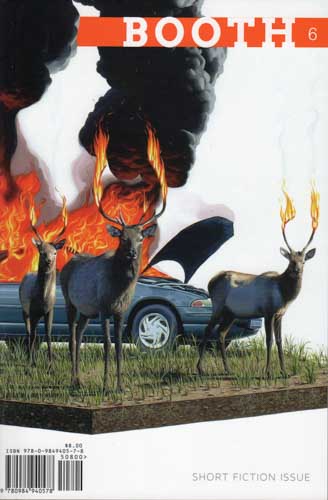Booth – Issue 2014
Playing parts both online and in print, Booth chose this year to put out a special short fiction issue, packed with many of the best pieces from the online edition as well as the winners of the 2013 Booth Story Prize. All the stories included in this issue are imaginative and well worth the read. Playing parts both online and in print, Booth chose this year to put out a special short fiction issue, packed with many of the best pieces from the online edition as well as the winners of the 2013 Booth Story Prize. All the stories included in this issue are imaginative and well worth the read.
The first inclusion is Jennifer A. Howard’s “The Lesser Coverts of Game Birds,” a brief introduction to a future world in which there are no birds: “Now, the world’s teenagers have never seen a live seagull, though it took a good while after the birds were gone for folks to stop saying everything tasted like chicken.” Howard uses this well-crafted world as a social commentary of the direction our own world may go:
Now that it’s dark all the time. . . we can’t know if anybody is really gone, or if we just can’t see them right now. The truth is we can’t know much anymore, we can’t make out anything clearly, or in real color. Black twig borers ate up all our coffee beans, so we never really feel awake. We talk to each other like we’re all still mid-dream, half-dreamt, and we never get all the way out of our pajamas or let down our nighttime ponytails. We reach back for talismans that no longer represent us because we can’t see where we’re headed.
Images become more real in the centerfold where Nick St. John contributes a graphic narrative titled, “How I Came to Work at Wendy’s.” Through simple black and white sketches, a wife tries daily to get her husband to find a job. Through his stubbornness and sheer need to be a writer, he simply cannot find a job. But with his humorous cover letters such as “Dear San Francisco Zoo, I am writing to enquire if you have any openings for the position of walrus,” it doesn’t come at much of a surprise. Any writer that has tried to make a living by only being a writer (and those too that accepted the difficulty early on) will find the humor in this piece and enjoy it fully.
Perhaps the most imaginative in the bunch is Ian Golding’s “In the Essence of the Gourd” which shows Charlie and Linus out on the street, performing for food and money and living in the pumpkin patch. Each day, Charlie creates a ruse for them to try out. As the story begins, they try Life with Brain Damage, Charlie Brown: “Everyone pitied a charity case, really dug deep in their pockets, and today Charlie was pulling out all the stops. He combed his few thick strands of hair to the side and rubbed glitter on Linus’s cheek.” If you’re looking for a story that is highly creative, entertaining, and just a wee-bit heart-warming (yet nothing like the heart-warming of the real Charlie Brown stories), then this one is not to be missed.
Structure, too, is an experience in this issue of Booth. Daniel Hales includes excerpts from his novel Run Story (which after reading I’d love to get my hands on), a hybrid/cross-genre ‘novel’ which takes place in a residential center for emotionally/behaviorally disturbed children and adolescents and is made up of lists, worksheets, log entries, reports, and letters. And Annie Bilancini tells her story from different points of view relating to the different characters at a beauty pageant, dialogue answers from questions at the show, lists, and narratives to give a well-rounded picture of what really happened at the Little Miss Bird-in-Hand County Pageant the year of “the accident.”
After reading this print issue of Booth, it clearly is the best of the best. And as they just came out with another print volume, I anticipate getting my hands on it. It’s definitely one of the journals I’ll be keeping an eye on.





